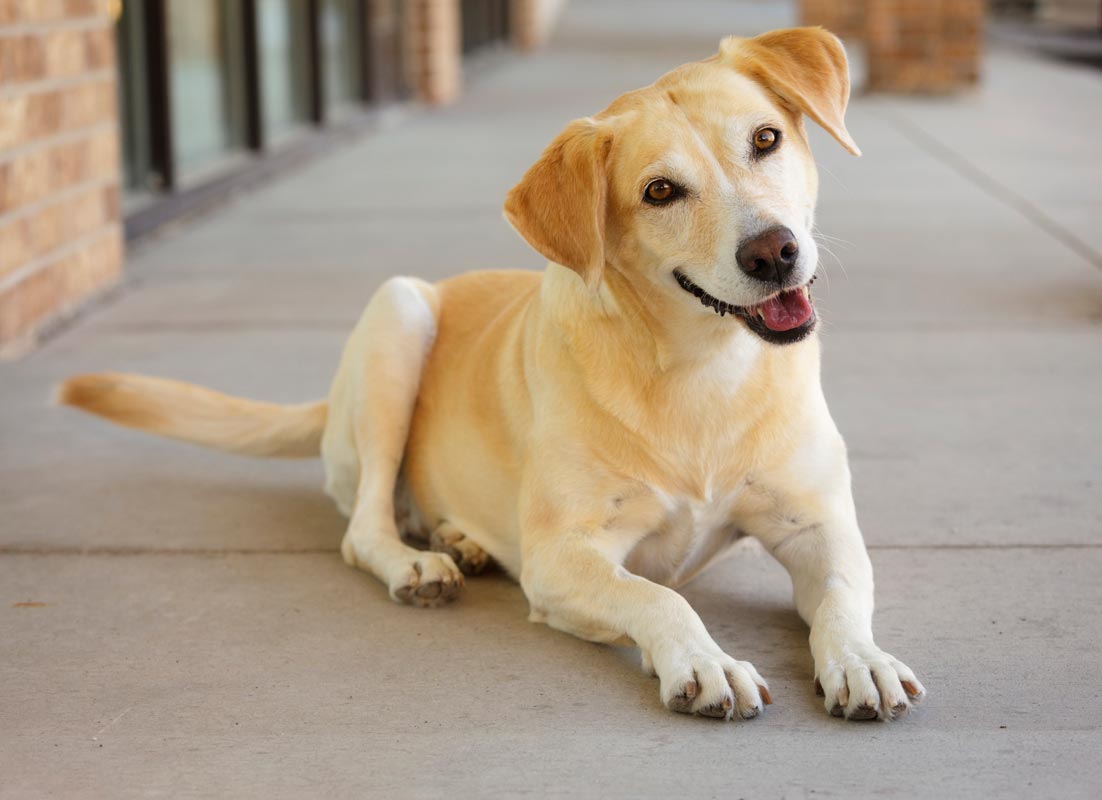Why Do Dogs Wag Their Tails?

Dogs are highly social animals that use a complex combination of body postures, facial expressions, and vocalizations to communicate with one another. Tail signals are an integral part of this canine code.
The History of Tail-Wagging in Dogs
Tail-wagging evolved among ancestral wild dogs as a type of communication system that could be easily spotted from a distance. This technique was enhanced even more by evolution. To increase visibility, some dogs' tails became bushier, some acquired a lighter underside, and others developed a contrasting white or black tip (Stanley Coren Ph.D., 2011).
At close range, tail-wagging might help disperse into the air the distinctive pheromone scents from a dog's anal sacs, located just inside the rectum. These pheromones also communicate important information from dog to dog.
Tail-Wagging Facts
Here are some interesting things to know about dogs and tail-wagging.
- Behaviorists note that the tail wag is an interactive gesture intended for another dog, person, or other live creature. Solitary dogs observed without their knowledge don't wag their tails much or at all.
- Some dogs wag their tails more than others. It varies by breed and individual. Of course, there is the classic hip-gyrating, tail-twirling, whole body wag of the typical yellow Labrador. Other dogs may be quite restrained and barely wag at all. This does not mean they are unfriendly or depressed; they are just more reserved.
- Dogs with docked tails (a cosmetically amputated tail such as in Rottweilers, Dobermans, schnauzers, etc.) still wag their phantom tails, but they may be at a slight disadvantage in getting their point across.
What Does a Dog's Tail-Wag Mean?
A relaxed and friendly dog will wag her tail as a cordial greeting that's analogous to a human smile. But a wag of the tail does not always indicate friendliness. It can also signal dominance, aggression, submission, or uncertainty. As is the case with most aspects of canine body language, it's important to read all of the cues together. Tail position, body language, and facial expression all play a part in deciphering what a dog is trying to "say."
Here are some things that the wag of a dog's tail may be trying telling you:
- "I'm happy to see you!" When a dog is attempting to tell you that she's happy, her tail is held in a neutral position and sweeps back and forth in a relaxed "U." The more excited the dog is, the more rapid the wagging. When this type of tail wag is paired with a play bow in which the dog bows down, elbows on the ground and rear end in the air, it means "Let's play!"
- "I'm in charge." The tail is held high and wags stiffly. The whole body is tense, legs spread, head held high, ears forward. This is the classic stance of a dominant dog.
- "Watch out!" The tail is held erect over the back, with tension, sometimes twitching. The body posture is confident, hackles raised, and the dog may stare, bare her teeth, growl, or bark. Sadly, many people misinterpret these cues, thinking that a wagging dog is a friendly dog, and get bitten as a result.
- "Don't hurt me!" The tail is tucked between the legs, and the tip oscillates quickly. This is paired with other submissive cues such as a crouched stance, retracted head and ears, averted gaze, and lips drawn back from the teeth. Some dogs may release a little urine.
- "I don't get it." Tail-wagging can also be considered a displacement gesture, one which shows that a dog is anxious or confused. A dog that looks up at you half-expectantly, half-quizzically, as her tail sweeps in a slow arc, is probably trying to figure out what you just said.
In general, a dog's tail starts out in a neutral, horizontal position. As it gets higher, it means the dog is more excitable, on alert, and potentially aggressive. The lower it dips from neutral, the more unsure, scared, and timid she is. You must evaluate this on a case-by-case basis because some breeds of dog have a neutral tail position that is normally higher or lower than others.
Here are two additional tail-related terms:
- Happy tail: This refers to a condition of dogs with heavily-muscled tails (e.g., Great Danes) and overly exuberant waggers (e.g., Labradors). The tail that wipes your coffee table clean in a single swipe can also get injured from constantly banging into things. As soon as the tail wound scabs over, it's knocked about and gets traumatized again. If your dog has a scab on the tail that isn't healing, it's time to see the veterinarian.
- Limber tail: Also known as "cold tail" or "swimmer's tail," this is a curious medical condition in which a dog's tail goes limp following vigorous swimming. It's thought that this results from fatigue or loss of circulation to the tail muscles. It typically resolves on its own within 48-72 hours. However, since a limp or lifeless tail can indicate other problems, including pain, vertebrae fracture, or a neurological condition, be sure to consult with your veterinarian if this happens to your dog.
Ready for a Really Weird Tail-Wagging Fact?
Researchers have discovered that the direction in which a dog wags her tail differs depending on the trigger for the wag. When a dog sees her owner, an unfamiliar human, or a cat, she wags her tail predominantly to the right (her right, your left when you're facing her) and the vigor with which she wags is greatest for her human.
However, when a dog sees an unfamiliar dog with dominant or aggressive body language, her tail wags more predominantly to the left.
Researchers have determined that this difference in tail-wagging direction has to do with the side of the brain that controls the emotions the dog is feeling when she is exposed to various stimuli. When her tail wags to the right, her left brain, which is associated with positive feelings, is in control. When her tail wags to the left, her right brain, which controls withdrawal and the trigger of the fight or flight response, is in charge (A. Quaranta, 2007).
This research indicates that dogs really do convey their emotions with their tails.
Works Cited
- A. Quaranta, M. S. (2007, March 20). Asymmetric tail-wagging responses by dogs to different emotive stimuli. Retrieved from Current Biology.
- Stanley Coren Ph.D., F. (2011, Dec. 5). What a Dog's Tail Wags Really Mean: Some New Scientific Data. Retrieved from Psychology Today.
You May Also Like These Articles:
Why Dogs Like to Roll in Yucky Stuff
Benefits of Multiple Dog Households
Dogs Make the Best Matchmakers
Why Do Dogs Chase Their Tails?
How to Cope with Canine Anxiety and Fear by Using Adaptil(TM) (Formerly called D.A.P)
Disclaimer: This website is not intended to replace professional consultation, diagnosis, or treatment by a licensed veterinarian. If you require any veterinary related advice, contact your veterinarian promptly. Information at DogHealth.com is exclusively of a general reference nature. Do not disregard veterinary advice or delay treatment as a result of accessing information at this site. Just Answer is an external service not affiliated with DogHealth.com.

